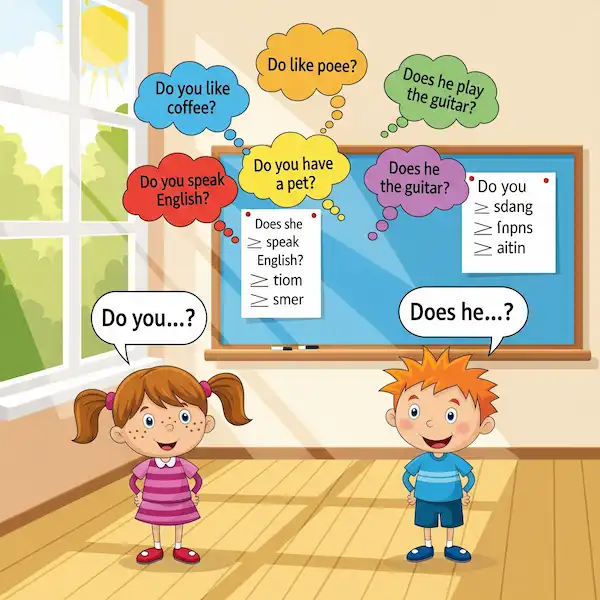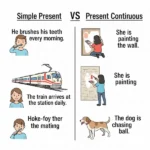Learning English? Let’s Talk Questions!
Have you ever wanted to ask someone something in English but weren’t sure how to start? Don’t worry, you’re not alone! Today, we’re going to unlock a super common and useful way to form simple English questions: using ‘do’ and ‘does’. This is a fantastic step for any beginner English student!
Why are ‘Do’ and ‘Does’ So Important?
‘Do’ and ‘does’ are like special helper words. They come to the rescue when you want to ask a question about everyday actions, habits, or facts. Instead of just stating something (like “You like coffee”), you can turn it into a question (“Do you like coffee?”). Learn how to ask simple English questions.
The Golden Rule: Who Are You Talking About?
The key to choosing between ‘do’ and ‘does’ depends on the subject of your sentence – that’s who or what is doing the action.
- Use ‘Do’ with:
- I (Do I…?)
- You (Do you…?)
- We (Do we…?)
- They (Do they…?)
- Plural nouns (e.g., The students, My friends)
- Use ‘Does’ with:
- He (Does he…?)
- She (Does she…?)
- It (Does it…?)
- Singular nouns (e.g., The cat, My brother, Sarah)
How to Form Your Simple English Questions: A Simple Recipe!
The basic recipe for forming questions with ‘do’ or ‘does’ is:
Do and Does + Subject + Base Form of the Verb + Rest of the Sentence?
Important Note: When you use ‘do’ or ‘does’ in a question, the main verb (the action word) always goes back to its simplest form (called the “base form” or “infinitive”). You don’t add ‘-s’ or ‘-es’ to the verb!
Let’s look at some yummy examples of using Do and Does!
Lots of Examples for ‘Do’
Talking about YOU:
- Statement: You speak English.
- Question: Do you speak English?
- Statement: You live in Phnom Penh.
- Question: Do you live in Phnom Penh?
Talking about ME (asking yourself or for confirmation):
- Statement: I need more time.
- Question: Do I need more time? (Imagine you’re asking your teacher.)
Talking about US:
- Statement: We have class tomorrow.
- Question: Do we have class tomorrow?
- Statement: We understand the lesson.
- Question: Do we understand the lesson?
Talking about THEM:
- Statement: They like pizza.
- Question: Do they like pizza?
- Statement: They work on weekends.
- Question: Do they work on weekends?
Talking about PLURAL NOUNS:
- Statement: The students study hard.
- Question: Do the students study hard?
- Statement: My friends play soccer.
- Question: Do my friends play soccer?
Lots of Examples for ‘Does’
Talking about HIM:
- Statement: He plays guitar.
- Question: Does he play guitar?
- Statement: He works in an office.
- Question: Does he work in an office?
Talking about HER:
- Statement: She likes to read.
- Question: Does she like to read?
- Statement: She cooks dinner every night.
- Question: Does she cook dinner every night?
Talking about IT (for things or animals):
- Statement: The cat sleep a lot.
- Question: Does the cat sleep a lot?
- Statement: The computer work fast.
- Question: Does the computer work fast?
Talking about SINGULAR NOUNS:
- Statement: My brother live here.
- Question: Does my brother live here?
- Statement: Sarah speak French.
- Question: Does Sarah speak French?
Practice Makes Perfect – Do and Does! Your Turn!
Try to change these statements into questions using ‘do’ or ‘does’:
- You watch movies.
- He eats breakfast.
- They sing well.
- The dog bark loudly.
- She teach English.
Answers:
- Do you watch movies?
- Does he eat breakfast?
- Do they sing well?
- Does the dog bark loudly?
- Does she teach English?
Additional Helpful Content for Beginners
Expertise: This article is designed by Teacher Kay with a focus on clear, step-by-step instructions, essential for beginner learners about how to use Do and Does.
Authoritativeness: The grammatical rules presented (‘do’ with I/you/we/they/plurals, ‘does’ with he/she/it/singulars, and the base form of the verb) are fundamental and universally accepted in English grammar.
Trustworthiness: The content is straightforward and avoids complex jargon, making it easy to understand and apply. The numerous examples build confidence in the learner.
Additional Helpful Content for Your Learning Journey – More Do and Does examples:
- Short Answers: When someone asks a ‘do’ or ‘does’ question, you can give a short answer!
- “Do you like coffee?” – “Yes, I do.” / “No, I don’t.”
- “Does she speak Spanish?” – “Yes, she does.” / “No, she doesn’t.”
- Negative Sentences: ‘Do’ and ‘does’ are also used to make negative sentences!
- “I do not (don’t) like coffee.”
- “She does not (doesn’t) speak Spanish.”
- Listen and Repeat: The best way to get comfortable with ‘do’ and ‘does’ is to listen to native speakers and repeat after them. Pay attention to how the questions sound.
- Real-Life Practice: Try to ask simple ‘do’ or ‘does’ questions in your daily life, even if it’s just to yourself! “Do I need to buy milk?” “Does this bus go to the market?”
Practice makes perfect
Here is a PDF worksheet you can download that has 25 practice sentences for using Do and Does. The answers are on a separate sheet.
Additional Helpful Information
- More information about do and does – Have/Has, Do/Does, Don’t/Doesn’t – 3rd Person Singular
- How to make past tense questions – Past Tense Questions: How to Use “Did” & “Didn’t”
Authoritative External Links for Further Learning:
- British Council – Do, Does, Did: A trusted resource for English language learning with clear explanations and exercises.
- Cambridge Dictionary – Do/Does in Questions: Provides a concise explanation and examples from a highly respected dictionary source.
- Grammarly Blog – Do vs. Does: Offers a user-friendly guide with a focus on common mistakes and usage.
Keep practicing, and soon you’ll be asking questions like a pro! Happy learning!




